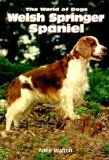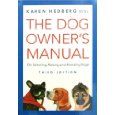About the Welsh Springer Spaniel
Sub-links for this page
Characteristics and Care of the Welsh Springer Spaniel
Description
The Welsh Springer Spaniel is a compact, medium-sized, working dog. The slightly rounded head is in proportion to the body with a slightly domed skull. The fairly square muzzle is about as long as the skull, but never longer. The nose is either black or any shade of brown with well open nostrils. The teeth meet in a scissor bite. The oval eyes are dark to medium brown in color. The long ears are set at eye level, hanging close to the cheeks fringed with hair. The topline is level. The tail was usually docked (prior to 2004) and is set at the topline and carried horizontally. Note: docking tails is now illegal in Australia and most parts of Europe. The soft, flat, straight or wavy coat is medium in length with feathering on the back of the legs, front of the chest & belly, with lighter feathering on the ears and tail. Coat colors come in a rich red and white in any pattern, sometimes with ticking. Note: the colour of baby puppies is often a soft red and usually doesn't reach the full rich red colour until 8 - 9 months of age.
Temperament
The Welsh Springer Spaniel is an active, loyal, and affectionate dog. They can be reserved with strangers, but are not timid, shy, or unfriendly. They are known for being affectionate to all members of the family, especially children, and accepting other pets of the household with a friendly, playful attitude.
The breed is a quick learner but is sometimes known to have selective hearing, especially if there is something more interesting in the environment. With correct training, they can become very obedient dogs.
The Welsh Springer was bred for work and endurance, and as such needs plenty of exercise to remain healthy and content. Without lots of exercise, a dog will become bored and design its own (destructive) means of keeping busy.
The Welsh Springer Spaniel has a well earned reputation for being an excellent choice for a home that has children and other pets, even including cats. However; its playful and easy going personality can tend to hide the fact that it is a dog that does not do well if it hasn't received some basic obedience training. They are an extremely sensitive dog and all training must be done in a very positive manner; harsh training techniques will destroy their outgoing temperament and also their relationship with their owner. They do better indoors than most dogs of similar size. but if given the choice would rather be outside chasing a Frisbee or a stick. This is because, it is an active outdoors breed that loves to go on hikes and explore any place that is full of green such as parks, rivers and lakes.
SEPARATION ANXIETY:
The Welsh Springer Spaniel has a world-wide nickname as the "Velcro Dog" as it has such a strong affection and affinity for his/her owner. However while this loyality and affection is a very positive quality it can lead to an undesirable (sometimes disturbing) anxiety disorder when the Welshie is left alone. The situation can be relativley easily avoided by appropriate training when the young puppy first joins his/her new home. This can be achieved by ensuring that the puppy has some "own time" every day. One way of doing this is 'crate training' where the puppy spends some time in a secure dog crate, out of sight of the family each day. This is also useful for transporting the dog in your vehicle when necessary. -- Please look at more information on this issue in the sub-page link at the top of this page.
Height, Weight
Height: Dogs: approx. 19 inches (48 cm.) Bitches: approx. 18 inches (46 cm.) - at withers.
Weight: Dogs: approx. 45 pounds (20 kg.) Bitches: approx. 43 pounds (19 kg.)
Health Issues
1 Hip dysplasia.
2 Glaucoma & Cataracts.
3 Epilepsy (although this is extremely rare in Australia).
All responsible breeders will have the relevant X rays and Eye Specialist examinations to ensure these issues are minimised as much as possible.
Exercise
The Welsh Springer Spaniel is an energetic and lively dog that needs plenty of regular exercise, including a daily long walk or jog. They will greatly enjoy running off the leash in a safe area. However they do NOT have a good road sense and should only be off leash while in safe and supervised conditions. Without enough exercise, these dogs will become bored, fat and lazy and are more likely to develop behavioural problems.
Grooming
The Coat of the Welsh Springer Spaniel is fairly easy to maintain and regular brushing with a stiff bristle brush will be enough. The coat is a beautiful silky texture; when they do get wet and dirty the dirt simply drops off when they dry! Bathe or dry shampoo only when necessary and use a coat conditioner. Trim the hair between the toes and level with the pads on the bottom. Regularly clip the nails - a small (metal - workers) rough file is very useful. Also trim the coat on the ears and the length back to nearly level with the leathers. This also keeps the ear coat out of the feed bowl and allows good air circulation of the ear canal thus minimising ear infections (that commonly plague English Springers and Cockers).
History and Origin
As dog breeds go, the Welsh Springer Spaniel's history and lineage is fairly ancient as it has been dated as far back as 7000 BC by researchers. If this is so, then this would make the ancestors of this breed one of the first dogs in history to ever be used for hunting purposes by humans. However; these same ancient ancestors of the Welsh Springer Spaniel are also the same line of early hunting dogs that many other breeds of spaniels trace their lineages to as well.
It was along the coastlines of Scotland, Wales, Brittany, Ireland and Cornwall that Mesolithic semi nomadic bands of hunters first used the ancestors of all of todays domestic hunting dogs to detect and assist in the killing of game of all sizes. As history progresses, we find the ancestors of the Welsh Springer Spaniel having developed into the Agassian hunting dog, which was being used for hunting by the tribes of Roman occupied Briton two thousand years ago.
It was in Medieval Europe that this same line of hunting dogs was further refined into a type of hunting dog that was commonly referred to as the Land Spaniel which has been depicted in artwork of that era. These depictions, mainly on tapestries, show a retrieving dog that is quite similar in appearance to the Welsh Springer Spaniel of today.
The Welsh Springer Spaniel remained a favorite of the aristocracy and landed gentry up until the 1800s when other spaniels and breeds of hunting dogs began to gain in popularity and replace the Welsh Springer Spaniel as the dog of choice for huntsmen in all regions of Europe. In fact, it was during the time that it was most popular that it was given the name "Springer" in recognition of its skills at flushing or "springing" game in the field during hunts.
It was also during these times in Europe that the dog that we know as the Welsh Springer Spaniels was often referred to as the Welsh Cocker and the Welsh Spaniel. It is important to bear in mind that during those earlier years in Europe there were no kennel clubs to regulate breeding, so often times spaniels were inter bred.
In the late 1800s the Welsh was separated into a different breed than the English Springer. The Welsh Springer was bred to find and spring at the game. Hardy, they were able to work in all types of weather and terrain, had great stamina on the hunt and could work for hours without resting. The Welsh Springer has a tendency to wander too far from the hunt field, and therefore it is necessary to give it constant training - beginning at about six months of age. The jolly disposition of the Welsh Springer makes him a fine companion and family dog. Some of the Welsh Springer's talents include: gun dog, tracking, hunting, retrieving and watchdog.
Reference Books

“The World of Dogs: Welsh Springer Spaniel”
Anne Walton 1999, Kingdom Books England.
Anne Walton is the President of the UK Welsh Springer Spaniel Club and an experienced Welsh Springer Spaniel breeder and Judge.

“The Dog Owner's Manual”
Karen Hedberg, 2006. The Watermark Press, Boorowa, Australia.
An excellent Australian general dog book written by an experienced & respected Vet.
